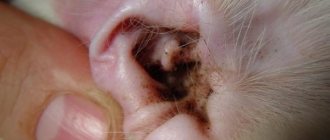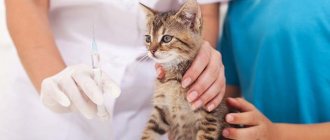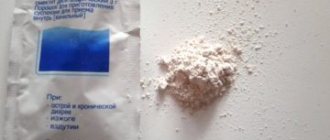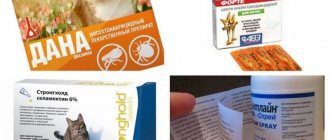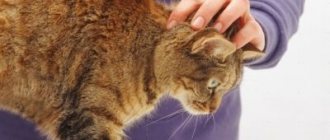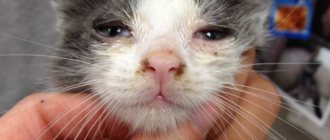Behavior of a cat when affected by ear mites
The disease can be detected in a pet by characteristic signs , since insects affect both ears at the same time.
Provoking factors for their spread are moisture and heat. When the ear canal is damaged, an inflammatory process occurs, which contributes to the abundant release of pus. This causes serious discomfort to the pet, and the unpleasant sensations are constantly annoying.
To identify the disease, it is enough to observe the cat’s behavior and check the ears for the presence of waste products of the parasite.
Characteristic signs of the disease affecting behavior:
- the cat becomes restless and cannot lie in one place;
- periodically shakes his head, meows pitifully;
- clings to the owner, tilting his head to the side;
- periodically scratches his ears on corners and furniture.
Infection can also be detected by the presence of purulent discharge that accumulates in the auricle, and by characteristic brown crusts directly in or near the ear.
Infection can also be detected by the presence of purulent discharge.
Lack of treatment leads to the penetration of the pathological process into the middle and inner ear, then the disease switches to the lining of the brain, which threatens serious health complications.
Symptoms of an advanced form of otodectosis:
- elevated temperature;
- dejected state;
- the head is constantly tilted towards the affected ear;
- periodic seizures.
An advanced form of the disease can cause death, so it is necessary to check the animal’s ears and respond in a timely manner to the unusual behavior of your pet.
Ear diseases in cats
There are several causes of ear diseases in cats: mechanical damage, inflammation due to hypothermia, viral or bacterial infections, fungal infections, wax buildup, allergies. The disease can affect one ear or both at once. A veterinary clinic will help you establish the correct diagnosis. Ear diseases in cats are divided into the following groups:
The resulting dark brown crusts gradually form a plug in the ear canal, which leads to rupture of the eardrum. When the integrity of the ear septum is damaged, the inflammatory process penetrates into the inner ear (labyrinthitis), and then affects the animal’s brain. Ear scabies are extremely dangerous not only for the health, but also for the life of the cat.
Otitis is an inflammation of the outer, middle or inner ear. The most dangerous type of disease is the latter, when the pathological process can spread to the brain or vestibular apparatus. Otitis media can be primary or secondary. The initial factors include: otodectosis, autoimmune disease, improper ear cleaning, frequent washing of the cat.
Before prescribing treatment for your pet, the veterinarian performs an otoscopic examination and collects material from the auditory canal. Special ear drops for cats with otitis media are prescribed with simultaneous administration of sulfonamides and antibiotics. For purulent otitis, before using the product, the ears are treated with a 3% solution of boric or salicylic acid.
Diagnostics
Treatment of otodectosis begins only after confirmation of the diagnosis in a veterinary clinic. Ear mites can only be identified after laboratory testing of the ear contents (discharge).
The doctor scrapes the ear and applies the collected contaminants to a laboratory glass and presses it on top with a cover glass. All this is placed under a microscope for examination. If there were parasites in the scraping, they will be visible under a microscope.
The second diagnostic method involves examining the animal’s ears using a magnifying otoscope. An otoscope helps to see parasites, their eggs and larvae.
Additionally, bacterial culture and cytological examination of earwax may be prescribed. In this way, concomitant diseases (bacterial and fungal infections) can be identified.
Only a veterinarian can confirm the diagnosis and suggest how to treat it. To do this, he will ask you to describe the cat’s living conditions and the symptoms noticed. The doctor examines not only the animal’s head, but also its entire body. He looks for scratches caused by itching. The diagnosis is confirmed only after taking a scraping and microscopy.
If the ear is not severely inflamed, an otoscopy is performed to determine the condition of the ear canal and eardrum. In advanced cases, bacteriological examination, computer or magnetic resonance imaging is performed. Only after this will the veterinarian be able to prescribe therapy. If a specialist has doubts about the diagnosis, he can refer the patient to a highly specialized dermatologist.
Important! There is no need to clean your cat's ears before visiting the veterinarian. This will complicate the diagnosis.
For those who love Animals
Ear mites, or Otodectes cynotis, are microscopic parasites that can infest a cat's ears. Parasites prefer the warm, dark ear, where they feed on dead skin particles. These mites create irritation and itching, causing the cat to scratch and scratch at the ears.
Scratches from claws can, in turn, cause problems such as skin infections or swelling of the ear septum. The disease will not go away on its own, so the disease should be treated as early as possible.
In addition to the fact that itching causes suffering for cats, even more than fleas, if left untreated, otoacariasis can develop - an infection. The consequences can be serious. If left untreated, it damages the ear canals and eardrums.
Ear mites are highly contagious and can be passed from cat to cat or cat to dog and vice versa, so it is important to treat all of your pets at the same time.
How to tell if a cat has ear mites
Ear mites cause dark brown and sometimes black accumulations in the ear flaps that look like dirt. A cat with healthy ears will have clean inner surfaces.
If a dark coating is visible inside, similar to coffee grounds or black dirt, this is a sign of a possible ear health problem. When the disease occurs, an unpleasant odor emanates from the ears.
Ear mites cause irritation, so cats will try to scratch their ears with their back paws and often shake their heads, which can cause fluid to splatter from their ears.
A cat's claws, when scratched, can damage the surface of the skin, leading to bleeding and, in some cases, bacterial infections.
Cats that have suffered from ear mites for a long time may develop inflammatory polyps (bumps or growths) in the ear canals, which, due to constant rubbing and scratching, begin to bleed.
In addition, inflammation with purulent discharge may begin in the outer ear, with further rupture of the eardrum. At this stage, it is no longer possible to do without the intervention of a specialist - a veterinarian. So when the first signs of the disease appear, treatment should begin as quickly as possible.
If you have several animals and you suspect one of them has ear mites, check the ears of all animals, as ear mites can easily spread between animals, especially if they sleep, play or mate together.
If you see any of these signs, you should take your cat to a veterinarian for a check. Your veterinarian will usually use several methods to diagnose your cat's problem.
Examines the outer ear canal with a special tool, similar to a flashlight with a magnifying lens, that is used to look deep into the ear canal.
In some cases, your doctor will collect samples of earwax on a cotton swab and examine them under a microscope. Check to see if the eardrum is damaged and if there are any obstacles to the free flow of drops into the ear.
Next, the doctor will prescribe the right medicine depending on the severity of the disease, as well as the right dosage, so you should not self-medicate and buy medications from pharmacies yourself.
If you decide to buy the medicine yourself, before use, carefully read the label with instructions on how often to use the drops. The frequency of treatment and the number of drops will depend on the specific medicine, but as a rule, you need to drop 2 times with a break of 7 - 10 days.
Among the drops to combat ear mites, the most effective at the moment are oil-based Ectodes drops. Such drops better envelop the inside of the ear and do not spill out when cats start shaking their heads after instillation.
Before using the medicine, the cat's ears should be thoroughly cleaned of dirt with a cotton swab dipped in warm boiled water.
How to put drops in a cat's ears
It is better to carry out the procedure of cleaning the ears and instilling drops with someone together. If the cat resists strongly, wrap it in a towel to avoid being scratched.
Clean your ears, apply drops according to the instructions, gently press the ear with two fingers at the base and lightly rub between your fingers so that the medicine coats the inner surface of the ear.
Cats do not like this procedure, as the composition of the medicine can cause tingling of the bite wounds. After instillation, the cat begins to shake its head vigorously, so after instillation, try to hold the cat's head for a while.
Prevention
After treatment, you should constantly monitor the cleanliness of your ears. Clean regularly with a cotton swab and water. Inspect other animals living together, including dogs.
Use fipronil spray, which kills ticks, fleas, lice and other parasites. It is applied to the animal's hind legs and is an antiseptic when scratching the ears.
Consult your veterinarian for a prescription spray or substitute. This treatment will also destroy ticks that get on the fur when cats shake their heads and prevent re-infection.
Ear mites are not transmitted to humans, but they bring a lot of suffering and complications to animals, so prevention and timely treatment are the key to your pet’s health.
The ears of a cat, even a domestic one, are a very good dirt collector. True, a cat is a clean animal, and diligently cleans its face along with its ears when it washes itself. However, once they notice dark spots or gray stains of dirt on the inside of the ear, many owners wonder how to clean their cat’s ears at home and whether it can be done at all. This is especially of concern to those owners whose pets must participate in exhibitions where judges are very strict about appearance.
What are the most effective remedies for ticks: drops, ointments or folk remedy therapy?
Finding a cure for ticks will not be particularly difficult.
To do this, you can use drops, ointments, folk remedies:
- drops on sale. You can choose a medicine for kittens, pregnant cats or elderly animals. One of the advantages of drops is ease of use.
- Ointments are the main medicine. Their range is not so wide, but they last much longer, which prevents the further spread of the mite deep into the ear. The disadvantage of ointments is that they are difficult to apply.
- Folk remedies . It is easy to prepare medications at home, but experts insist that it will not be possible to eradicate the parasite using folk remedies; it will only waste time. The best you can hope for is a reduction in the insect population.
At the initial stage of infection, it is recommended to use drops, and at an advanced stage, additional ointments should be used. Folk remedies are suitable for preventing infection during dangerous periods of the year.
Everything is very simple
The main rule: at home you can only clean the surface of the outer ear. Under no circumstances should you climb inside, even with cotton swabs or chopsticks. The doctor, if necessary, sometimes uses tools similar to cotton swabs to reach dirt that is too deep in the ear. But this is a doctor, and the owners, as a rule, do not have such experience, and the result of an incorrectly performed hygienic procedure can be otitis media or injury to the inner ear.
First, you need to clean the surface of the ear with dry cotton wool to remove recently accumulated dust. Then slowly and carefully remove any dirt stuck to the skin with a moistened swab. There is no need to rush: you should definitely change the cotton wool as it gets dirty. Do not twist the ear too much.
Some owners mistakenly believe that before treating the auricle they need to instill some kind of solution there. This is not required to clean the skin. It’s another matter if the veterinarian prescribed special means for prevention, but they must be instilled only after cleaning, otherwise the product will be less effective, since dirt will not allow it to reach the skin.
Treatment of a kitten or pregnant cat
The insidiousness of the disease is that otodectosis often occurs in kittens. But, judging by the statistics, animals of any gender and age get sick. Whether it is a small kitten, a pregnant cat or an adult cat, the disease makes no difference.
Kittens can become infected with otodectosis from their mother.
In case of pregnancy or young age, drugs are used to treat otodectosis in cats, which are prescribed in the instructions for use.
Why do cats get dirt in their ears?
Everyone knows that cats are very clean. They diligently lick their skin, wash their faces with their paws, but they cannot ensure the cleanliness of their ears. Although a healthy cat does not need frequent cleaning of its ears: long hairs reliably cover the ear cavity from dust and a small amount of wax released as a result of natural functioning does not pollute the ear canal. The exception is artificially bred breeds in which changes in the body have also affected the structure of the ear (for example, the Sphynx).
And yet, when carrying out hygiene procedures with your pet, you must not forget to examine the ear cavity and, if necessary, remove dirt using cotton swabs, discs and special lotions. If, within a few days after cleaning, you again notice dirt in your cat’s ears, this indicates a disease and the need for urgent treatment.
Table: ear diseases in domestic cats
| Type of disease. | Causes. | Signs. |
| Otodectosis. It is caused by Otodectes cynotis, a parasite that lives in the ear cavity and feeds on the epidermis and lymph. The substances produced as a result of its vital activity are weak toxins for cats, but in large quantities can cause poisoning. The mite multiplies quickly and, if left untreated, can spread further into the ear. Otodectosis is not transmitted to humans. | In most cases, infection occurs through contact with a sick animal, since ear mites can exist without a host for only about ten days at a temperature of at least twelve degrees. Healthy animals with good immunity usually do not become infected. In the danger zone are young and elderly individuals with weakened protective functions of the body. | Symptoms of the disease:
|
Otitis is an inflammation of the ear. Depending on the spread of the disease through the ear canal, several types of otitis media are distinguished:
Otitis externa is easier to treat; drops and lotions are used to combat it. More severe cases require the use of antibiotics. | The causes of otitis media in a pet are varied:
| The inflammatory process in the ear is accompanied not only by itching and contamination of the inner surface of the auricle, there are also other features:
|
| Fungal disease - otomycosis (fungal otitis media). This disease can be fatal. | The cause of such otitis in most cases is yeast fungi that are constantly present in the surrounding world. For a healthy cat, they are not only not dangerous, but are also a kind of symbionts, protecting its skin from penetration of foreign microorganisms. When immunity decreases under the influence of external factors:
yeast fungi can turn into a causative agent of the inflammatory process. | The signs of otomycosis are similar to the manifestation of otitis media of bacterial origin, but there are some differences:
Laboratory tests performed by a veterinary clinic help to accurately determine the cause of otitis media. |
Video: ear diseases in dogs and cats
Consequences of a dangerous disease
Otodectosis is distinguished by rapid development, but in its course there are still three stages. At each of them, several more are added to the list of symptoms.
First stage
The first stage lasts 4-5 days, already at this moment an attentive owner can notice that something is wrong with the pet. He begins to worry, scratching his ears because of itching, and the skin of the ear canal turns red.
Second stage
At the second stage, the following symptom is added to the itching and hyperemia of the ear: brown discharge and discharge. Earwax turns black and looks like ground coffee. The cat begins to itch more, sores form on the skin and become covered with crusts. An unpleasant odor appears.
Third stage
At the third stage, it is quite difficult not to notice the disease: the cat is depressed and lethargic. Often by this time, the entire muzzle, areas under the lower jaw and behind the ears are combed to the wounds.
We suggest you read: How to get rid of period in chickens using folk remedies and treatment with drugs
Note! Otodectosis can affect one ear, but not both, so you need to pay attention to the condition of each of them.
Despite its apparent harmlessness, this disease is dangerous and can lead to the following consequences:
- hematomas, eczema;
- pyogenic infection;
- convulsions;
- otitis – inflammation of the middle ear;
- inflammation or perforation (damage) of the eardrum;
- as a result, partial or complete deafness;
- fever;
- brain abscess;
- meningitis - inflammation of the meninges;
- coma;
- death.
Psychological preparation
A cat's ears are one of the most sensitive places, and most cats absolutely do not like this hygiene procedure. Therefore, at home, it is more important not how to clean a cat’s ears, but how to accustom her to this. And this must be done from childhood. The animal must trust the owner and not be afraid when he carefully strokes or touches the ears.
But if the animal does not want to sit quietly, then it should be well restrained. You may need the help of an assistant who will hold the cat: after all, both hands are needed to properly clean the ears.
How to use various remedies for ear mites in cats
Before using medicinal drops, it is recommended to first clean the inflamed ear from scabs, then drip 3-5 drops of the medicine into each ear. If necessary, therapy should be repeated after 5-7 days.
Attention! Even if only one ear is inflamed, the drug is still injected into both.
In case of severe damage, the method of application is to treat every other day until the unpleasant signs of infection disappear.
Ear drops for cats for otitis media
Quite often, pet owners turn to veterinarians complaining that their cat is constantly scratching its ears. What to do in this case? A common cause of itchy ears in cats is otitis media, an inflammation of the ear. This disease is caused by the following reasons:
- foreign body;
- hypothermia.
This disease is manifested by the following symptoms that are difficult to miss:
- the cat scratches its ear;
- shakes his head;
- discharge appears from one or both ears.
But even if you independently discover, in your opinion, obvious signs of otitis, the final diagnosis should be made by a veterinarian based on research and test results. He will prescribe the necessary treatment.
Treatment procedures begin with rinsing the ears with 70 percent medical alcohol. Treatment of the disease depends on the location of the inflammation. The cat's hair inside the ear is cut off and the ear canal is treated with an alcohol solution (boric acid solution, iodine, hydrogen peroxide). Prednisolone is applied to the dried surface.
For ear pathology, the veterinarian will prescribe treatment after a thorough examination and diagnosis. The presence of otitis media can be determined by serous or purulent discharge, redness, itching, irritation or swelling of the inner cavity of the auricle. The animal shows anxiety; when trying to examine the ear, the cat meows loudly or screams in pain.
Aurikan
These ear drops are used for the prevention and treatment of otitis, otodectosis and hygienic treatment in cats. The active ingredients of Aurican are as follows (in 100 ml): diazinon - 0.05 g, prednisolone sodium sulfobenzoate - 0.03 g, tetracaine hydrochloride - 0.2 g, hexamidine diisethionate - 0.05 g. The drug is a slightly opalescent (with glow) transparent colorless liquid. Aurikan drops belong to combined preparations with antibacterial, acaricidal, anesthetic and anti-inflammatory effects.
The method of application is based on instilling 5 ml ear drops for cats into the ear canal, previously cleaned of crusts and exudate. No symptoms of drug overdose have been recorded. Contraindication is individual intolerance, hypersensitivity to any component.
Otibiovin
These ear drops for cats contain the following active ingredients (per 20 ml): triamcinalone acetonide - 0.5 mg, gentamicin sulfate - 2 mg, salicylic acid - 5 mg. The medicine is a clear solution. This aminoglycoside antibiotic has a bactericidal effect on many gram-negative and some gram-positive bacteria.
The medicine is instilled into the animal's ear canal several times a day. Initially, therapy 3-4 times a day, after three days the dosage is reduced to 2-3 approaches of 4-5 drops. Treatment lasts until complete recovery (approximately 5-7 days). Contraindications – rupture of the eardrum, individual intolerance to one of the components.
Otonazole
The active ingredients of this complex drug for cats (per 1 ml) are miconazole nitrate – 23 mg, prednisolone acetate – 5 mg, polymyxin bisulfate – 5500 IU. In appearance, the medicine is a white suspension. Otonazole drops have antimicrobial, anti-inflammatory, antifungal effects. The antibiotic in the drug acts on gram-negative bacteria.
The medicine is instilled 3-5 drops into the cat’s previously cleaned hearing aid. For better distribution of the drug, the base of the auricle is massaged with light movements for several seconds. After the disappearance of clinical signs, the medicine is used for another 2-3 days to consolidate the effect, but the course should not exceed two weeks. There are no contraindications for the drug; there are no side effects or complications. The approximate price of Otonazole drops is 230 rubles.
Prevention measures
The appearance of a parasite is easier to prevent than to treat. Any drug based on acaricides has a depressing effect not only on insects, but also on the pet itself.
To avoid infection, it is recommended to adhere to the following prevention rules:
- Avoid contact with street and sick cats.
- Check your ears regularly for infection.
- Carry out hygienic cleaning of ears with special lotions.
- During dangerous periods of the year, use a tick and flea collar.
- Boost your pet's immunity with a balanced diet.
Prevention of ear inflammatory diseases
Almost all preventive measures to prevent the occurrence of inflammatory processes in the organ of hearing come down to the usual maintenance rules:
- periodically, but on an ongoing basis, inspect the ear canal of your pet and clean it of accumulated earwax with special means. There is no need to go deep into the ear canal. Preventive cleaning consists of cleaning only the inner surface of the auricle;
- Avoid keeping your cat in damp rooms for long periods of time, which may pose a risk of hypothermia;
- try not to get water into your ears while swimming (if this happens, it is recommended to blot the inner ear canal with a loose cotton swab);
- regularly carry out preventive treatment against fleas and ticks, and also exclude contact of your pet with yard and homeless people;
- carry out tick and flea treatment for all surrounding pets, as well as items for the care and maintenance of the pet.
Otitis is very dangerous due to its consequences.
It is unwise to independently treat a pet, literally risking not only its health, but also its life. Warning
: Invalid argument supplied for foreach() in
/home/shatkov/site/www/wp-content/plugins/custom-blocks/custom-blocks.php
on line
4642
Ear diseases in cats often pose a danger to the pet, as they can significantly worsen his condition or even lead to inflammation of the brain. A careful owner should notice signs of pain or inflammation in the ears and take appropriate measures. To treat this pathology, ear drops for cats are most often used.
The indication for their use is otitis media of various etiologies:
- Bacterial. Most often caused by gram-negative bacteria. Otitis in this case is often purulent in nature, the disease is accompanied by high fever and intoxication syndrome.
- Fungal. Caused by pathogenic fungi, it leads to hearing impairment, inflammation, and swelling.
- Otodectosis. Another name is ear scabies. The causative agent is ear mites.
Drops are used to eliminate the cause of otitis media, as well as to reduce inflammation, swelling and pain.
Ear cleaning procedure
Before starting the procedure, prepare everything you need.
The upper part of the ear is cleaned with a cotton sponge or neutral wet wipes.
For the lower one, it is advisable to use children's cotton swabs with limiters - this way there is less risk of injuring the animal. You need from 2 to 4 of them for each ear, depending on the degree of contamination. You should not use the same stick for different ears, even if it seemed to remain clean.
Prepare enough blades and chopsticks so that you don't have to take a break because you don't have enough.
Do not use homemade matchsticks - the cotton wool can easily slip off and remain in the ear. In addition, in this case there is a high risk of scratching the animal.
Some experts do not recommend using sticks at all, noting that there is a risk of only pushing the sulfur deeper. Instead, they suggest pouring in the cleanser one at a time for several days in a row until the stains are gone.
If possible, prepare a small flashlight - it will allow you to better examine the auricle. If necessary, warm the cleanser to room temperature.
It is best to carry out cleaning when the cat comes on its own and asks for attention or is half asleep. During the procedure, talk quietly and gently to your pet to calm him down.
How to clean a cat's ears:
- Place your pet on a table or in your arms. If he is calm about the procedure, you can simply hold him with your hand; if he breaks out, carefully swaddle him in a towel or call an assistant.
- Gently turn the ear outward - this is not painful and will not harm the animal. With fold-eared cats, as well as those with curled ears, for example, curls and lefties, you need to act especially carefully. Carefully examine the ears for symptoms of disease.
- Place 5-7 drops of lotion or saline solution into your ear - the manufacturer should indicate the exact dose. For kittens, 2-3 drops are enough. Gently massage the base of your ear for a minute.
- Allow the cat to shake its head and shake the liquid and loosened dirt out of the ears. For light contamination this is sufficient.
- If the ear is heavily soiled, wipe the upper part of the ear with a sponge and clean the lower part with a cotton swab. It can be immersed to a depth of up to a centimeter, for kittens - half a centimeter. Don't be afraid to pierce your eardrum - this is impossible due to the curves of the auricle, although you still need to act carefully. Move the wand outward rather than inward to remove dirt rather than push it deeper.
- After cleaning is complete, praise and pet the animal and reward it with a treat.
Accustoming kittens to the procedure
It is very important to teach your pet to calmly endure the ear cleaning procedure, otherwise in the future, by struggling and resisting, he will complicate the owner’s task, and besides, by jerking at the wrong moment, he can seriously harm himself.
It is advisable to play with the baby in advance so that he gets tired and calms down. It’s not worth interrupting the game in the midst of it - the kitten will be too excited and will probably resist, and the procedure in this case will cause unpleasant associations for it.
An animal accustomed to the procedure from childhood most often perceives it calmly.
Stroke the prepared animal, talk softly and affectionately to it to calm it down. If the kitten still resists touching its ears, you can restrain it by carefully wrapping it in a towel. Please note that you cannot express your dissatisfaction with the animal or scold it, much less act rudely. Even when swaddling a kitten, speak in a friendly manner. Praise him in moments of calm and obedience.
After completing the cleaning, be sure to give the kitten a treat and, if he wants, play with him - the procedure should be associated with pleasure.
The attitude towards ear cleaning largely depends on the character of the animal. Our first cat never struggled or showed aggression during the procedure; he only pressed his ears to his head with force, so it took some effort to straighten them. Since at the same time he usually sat quietly next to her, without trying to escape, it seemed that he saw this as a kind of game.
If your pet reacts aggressively to the procedure, trim the nails in advance or attach anti-scratch guards to them.
Ear cleaning technique: persistence and caution
Before cleaning your cat’s ears, prepare the necessary tools: cotton or gauze sponges, ear cleaning lotion, prescribed medications. Do not use cotton swabs, tweezers, matches or other hard objects!
How to properly clean a cat's ears:
- Take the cat in your arms, calm it down, stroke the sides of the face, not the top of the head. This type of stroking imitates the feline element of communication and trust. Try to avoid using force. If the cat resists too desperately, make several approaches that imitate hygiene procedures. Do this every time before feeding or playing.
- Wrap a damp sponge around your index finger - this is the ideal tool for sensitivity. You only need to clean those areas that are visible and accessible without the use of tools. A few minutes before cleaning, you can drop a special lotion into the ear canal - this will help “lift” dirt from the depths of the ear and make it more pliable.
- Clean each ear with a separate wipe. Using movements from the inside out, you need to move the sponge from the inside of the ear to the outside. Try to carefully clean every wrinkle. Do not rub or press, especially if there is inflammation.
- After cleaning, you can put ear drops into each ear canal, even if there are signs of disease in only one ear. Also put 1-2 drops of the drug into the healthy ear. When the drop hits the ear curl, fold the ear in half lengthwise and massage the base of the auricle - this way the drug will spread better.
- Hold the cat for a while so that it does not shake itself off after the administration of the medicinal drug.
Review of ear mite medications for cats
The disease is caused by a tick. The parasite colonizes the external auditory canal, feeds on the exfoliating epidermis, irritates nerve receptors, which is accompanied by unbearable itching.
The cat scratches the damaged surface, ichor comes out, and clogs the ear canal with crusts that look like ground coffee. Favorable conditions are created for the development of conditionally pathogenic fungi and bacteria.
To treat otodectosis, external agents are required that contain acaricidal, antiseptic, and anti-inflammatory components that are safe for cats. In order for the medications to work, the ear canal is cleaned, freeing the pathological surface from deposits.
Cleaning ears for otodectosis
To clean the ear canal, prepare cotton swabs, a specialized product for softening dried ear discharge, and a towel for fixation. Cats do not tolerate violence, so the operator cleaning ears must take care of his own safety.
If the instructions for use of the drug stipulate that it should be used as a means to soften crusts, no additional means will be required. The effectiveness of treatment is determined by the presence of a mite in the skin scraping in combination with clinical symptoms. One medication is chosen for treatment. It is prohibited to use two medications containing acaricides. Some drugs have no contraindications for use. But this does not mean that they are completely harmless: very rarely, some cats have a hypersensitive reaction to the components of the drugs.
for animals
Veterinary products under this brand are produced by the domestic research and development company. Since 1993, this organization has been supplying animal products to the Russian and foreign markets: medicines, care products, vitamin complexes. The demand for NVC products is explained by their high quality and affordable price. All drugs developed by this company together with leading Russian scientists are registered and certified in Russia and neighboring countries.
The center was able to achieve a high level of production by equipping the laboratory and technical control department with modern equipment and attracting highly qualified personnel. This makes it possible to control the entire production process - from the selection of raw materials to the release of finished products.
List of drugs
The following dosage forms are used:
Ivermek-gel
The active ingredients are the acaricide Ivermectin, an analgesic and a wound healing agent. Both hearing organs are treated, even if only one is affected, 1…2 times, duplicating them after 5…7 days. Contraindicated for breeds sensitive to Ivermectin, convalescent and malnourished cats.
Amidel-gel
Active components - acaricide, analgesic, antimicrobial agent, auxiliary wound healing substances. Both channels are processed 1. 2 times, duplicating, after 5...7 days. Contraindicated in kittens up to 2 weeks old, convalescent, and sick.
Aversectin ointment
The active component is Aversectin. To clean the ear from crusts, additional means are needed - lotions or Perhydrol. The wool is cut. Apply the ointment, fold the shell in half, and massage the base of the ear. Contraindicated for breeds sensitive to Aversectin, kittens under 2 months old, lactation, convalescent, and sick.
Surolan
Aurikan
Amitrazine
Ear drops. The active ingredients are acaricide Amitraz and Dimexide, which have antiseptic, anti-inflammatory and analgesic properties. The ear is folded and massaged. Treatments are repeated every other week until symptoms disappear.
Ectodex
Ear drops based on Propolis and Sulfur. Preliminary cleaning of the ear canal from secretions is required. Treatment consists of two or three treatments every 5...7 days. The medicine is contraindicated for pregnant, lactating, and animals under one month of age. Do not use the drug if the integrity of the drum membrane is damaged.
Anandin plus
Ear drops. The main active ingredients are the acaricide Permethrin, the immunostimulant Anadin, and the antiseptic Gramicidin. Preliminary cleaning of the ears is carried out with the same drug used for treatment. The hearing organs are massaged after instillation of the medicine. Therapy lasts 3...7 days. If the use of Anandin is missed once, the course of treatment is resumed.
If the cat shakes its head, prevent droplets from splashing with restraint. Contraindication: violation of the integrity of the tympanic membrane.
Ear drops consisting of Amitraz and Prednisolone. The crusts are soaked with a swab soaked in Amit. Ears are treated twice a day. The course of treatment is 3...5 days. If a second infection occurs, change the drug. Contraindications: gestation, lactation, age less than 2 months.
Dekta
Ear drops consisting of Amitraz, Propolis and Dexamethasone. Apply once, with an interval of 5...7 days. Number of treatments 2…3. Contraindications: gestation, lactation, age less than a month.
Drops in the form of pipettes. The main component is the organophosphate disinfestant Diazinon.
After instilling the medicine, the ears are massaged. A week later, the treatment is duplicated. The medicine should not be used by pregnant or lactating animals, as well as animals under 10 weeks of age.
Mycodemocid
Drops. Consist of Sea buckthorn oil, Chlorophos, detergent Isopropyl alcohol. Treat once and repeat 7 days later if necessary. Contraindicated in pregnant and lactating animals, young animals under 10 weeks of age.
Ivermek-spray
Analogue of Ivermek-gel. Inject into the ears twice with an interval of 3...5 days. Put on the Elizabethan collar until the surface of the ear dries to avoid licking. The drug is not prescribed to animals under three months of age, lactating animals, matrons, and cats that are hypersensitive to Ivermectin.
Acaromectin
Active ingredient: Ivermectin. Moisten the affected area generously. The treatment is repeated after 8…10 days. Requires 3...4 injections. Before the wetted surface dries, put on the Elizabethan collar. Contraindicated in pregnant, lactating and under-one-month-old animals.
Neostomazan
An emulsion that is a means of killing insects. The contents of the ampoule (1 ml) are dissolved in 0.2...0.4 l of water and the ear canal is generously moistened. A week later, the procedure is repeated.
Medicine against otodectosis for the treatment of cats
First of all, acaricides are used:
- ear drops (“Aurican”),
- gels and ointments (“Amidel-gel”),
- aerosols (“Acaromectin”),
- drops on the withers (“Frontline”, “Stronghold”),
- systemic action in advanced cases (“Otodectin”).
In addition, the following may be useful:
- antibacterial agents (Sinulox, Doxycycline)
- antifungal in case of otitis (Clotrimazole, 1% Tolnaftate solution);
- antihistamines, if the cat is allergic to mite metabolic products and their bites (Suprastin, Tavegil);
- immunomodulators (“Fosprenil”).
Usually the animal is treated at home without being hospitalized. Tablets and ointments are fairly simple medications for self-administration. The veterinarian will suggest leaving your pet at the clinic only if the infection has affected the inner ear or meninges. In this case, the cat needs constant medical supervision, since its life is at risk.
Anti-otodectosis drops for cats are the most effective solution if you need to choose one acaricidal drug. To do this, 4-6 drops are injected into each ear. Treatment is carried out three times at intervals of a week.
Attention! Both ears are treated, even if otodectosis has spread to only one. Otherwise, the mites may migrate to another area, and you will have to start the whole treatment all over again.
The instructions for use of the drug indicate that side effects and complications during the use of antiparasitic ointment are diagnosed extremely rarely. Side effects occur with individual hypersensitivity to the components of the antiparasitic drug. Hypersensitivity to Aversectin ointment appears in the form of:
- the occurrence of hyperemia of skin areas;
- itching and burning;
- the appearance of blisters and bumps on the skin.
If characteristic signs of an allergic reaction appear, it is necessary to remove the composition from the pet’s body as soon as possible using dry wipes. Then you need to bathe the cat with warm water and shampoo. It is recommended to give your pet an antihistamine.
Contraindications to the use of Aversectin ointment are:
- acute phase of an infectious disease;
- the cat is underweight (emaciated);
- during gestation of kittens and during lactation.
Note! It is not recommended to use the ointment on small kittens under 2 months of age.
Ear diseases in cats
Dermatitis or eczema
This disease affects the upper layers of the epidermis, this symptom allows the veterinarian to immediately make a diagnosis.
Some owners do not pay attention to eczema for a long time; as a result, treatment is delayed for a long time. It is important to diagnose the disease in time, establish the causes and further treatment.
To prevent the disease from developing into a chronic condition, it is important to start treatment on time when the first symptoms of the disease are detected.
The reasons for the development of eczema in cats include:
This disease cannot be treated at home. The main task is to destroy the main cause of the disease, often a pathogenic fungus.
Therefore, complex treatment is prescribed, which includes:
- Bathing a cat with special preparations;
- Injections;
- Proper nutrition.
Lubricating affected areas;
Yeast fungus
One of the diseases caused by yeast fungus is candidiasis.
Causes:
- excessive use of antibiotics;
- cancerous tumors;
- viruses and bacteria.
The fungus develops on injured areas and mucous membranes.
Symptoms of candidiasis:
- inflammation of the skin;
- peeling;
- sudden hair loss;
- when it appears on the mucous membranes, vaginitis and stomatitis may occur.
The disease is diagnosed using a smear of the damaged area. Various methods are used for treatment, often antifungal drugs. Depending on the severity of the disease, complications and relapses are possible.
Another disease caused by yeast is Malassezia infection. This fungus lives on the skin and ears of cats.
The cause of fungal growth is:
- weak immunity;
- inflammation of the skin;
- allergy;
- hormonal imbalances.
Symptoms include:
- Redness of the skin.
- Rash.
- Peeling.
- Unpleasant smell.
Let's celebrate! For diagnosis, skin scraping and examination of the cat's ear secretions are used. Treatment consists of regular treatment of the affected areas with antifungal drugs.
Say goodbye to pests FOREVER!... An environmentally friendly device that repels rodents and insects will help in the fight against rodents and insects...
Also, the cause of otitis may be an allergy to various irritants. This causes itching and further sores. Otitis media can become a complication due to other diseases, or it can be an independent disease.
We invite you to read: Dichlorvos for fleas in an apartment: how to safely treat the room
Symptoms of otitis media include:
- The appearance of irritability in a cat.
- The pet begins to rub his ear.
- He presses his sore ear to his head.
Later pain appears, it can be different. Acute pain brings suffering to the “pet”; the cat can jump up sharply and become fearful.
When the pain aches, the animal does not allow you to touch the sore ear, tries in every possible way to escape, and presses its ear to the bedding.
Let's celebrate! Often, otitis media develops slowly and there may be no signs of the disease. However, if the owner notices any deviation in the cat’s behavior, it is necessary to immediately go to the doctor.
Ear mite
Some owners think that if the cat stays at home, then the risk of tick infection is minimal, but this is not the case. Infection can occur through contact with another sick animal, or after contact with household items.
A tick can enter a house with its owner, from the street or entrance. Flies and fleas can act as carriers of ticks. These ticks are not dangerous for humans.
- cat anxiety;
- the pet begins to rub its sore ear against various objects;
- the appearance of discharge from the ear.
Let's celebrate! In order to prescribe treatment, it is necessary to find out the correct diagnosis. The veterinarian examines the ears using special instruments.
Routes of infection
Interestingly, cats can only get ear mites from another sick animal. This is due to the fact that the parasites themselves quickly die in nature without a host.
Veterinary practice shows that ear mites in cats can only appear through contact with other animals on the street. The disease is transmitted from the mother to the kittens. There is a high risk of infection for those animals whose owners often turn to specialized hotels. This is due to the fact that they are kept in group rooms there. It is this factor that does not guarantee that there will not be an infected animal among them.
The source of infection is always another sick animal
Ear mites feel equally comfortable on cats of any breed, regardless of the size of their fur and their preferred habitat.
Diagnostics
For treatment, it is necessary to make sure that the cat really has a tick and not some other lesion. This is due to the fact that there is another disease that looks very similar to otodectosis, refers to skin parasitosis, and is called notoedrosis, as it is caused by the mite Notoedres cati. It is for this reason that for treatment it is very important to accurately determine the source of infection, since this will require its own medications.
The difference is that during notoedrosis, the outer side of the auricle of animals is affected. Therefore, the animal, feeling severe itching, begins to literally tear at the affected area, as a result of which severe scratching can be observed. If, when infected with otodectosis, an animal may not show its disease in any way for several years, then notoedrosis will be visible immediately due to the fact that the sick animal will rip its ears until they bleed.
A cat can become infected with notoedrosis not only through contact with a sick animal (cats, dogs and rodents are carriers), but also through interaction with common objects - a bowl, bedding, etc. This disease is also dangerous for humans; it goes away within a month even without drug treatment .
Stages of notoedrosis damage
Treatment
First of all, the mite mass, which usually collects in crusts, is removed from the ears. To do this, use a cotton swab dipped in any vegetable oil. When the ears are completely cleaned, they are treated from the inside with drugs such as Amitraz, Hexachloran, Tsipam, Amitrazine. The procedure is carried out five times every three days.
At the same time, apply ear mite drops (for cats) “Aurican” every day for seven days. Treatment is continued for a month, but the ears are instilled twice a week. The fur around the affected ear is moistened with Neostomazan solution. For preventive purposes, Stronghold, Bars, and Frontline are used. During the treatment period, the animal is isolated from contact with other pets.
Today there are many drugs for the treatment of this disease, so a veterinarian or a pet pharmacy worker will help you choose the appropriate ear mite drops for cats. In addition, the clinic may recommend natural remedies that are no less effective than chemicals that are contraindicated for kittens, pregnant cats and weakened elderly animals.
Ear mites in a cat
Oh those ears, those ears. It was not my ears, but two huge pink and white mugs that pierced my heart like an arrow! This is what I remember when Hryundel appeared with us. In front of the cat, beautiful huge ears came out of the carrier, and behind them a small fluffy ball appeared.
At first we just admired the ears; the cat had a whole bunch of problems. But a month later, when the kitten had already settled in and it was time to go for vaccination, something pulled me to take a closer look at the ears. And there... In general, a terrible black substance completely covered the ears.
And how can such a small cat contain so many sores? I sighed. And the ears went to see a doctor
I’ll say right away that ear mites in cats are not a rare disease at all. It usually affects both yard murziks and domestic cats that accidentally came into contact with a sick animal. Even the owners themselves can bring ear mites on shoes into the house from the street or from the entrance.
It is also important to know that ear mites in cats are an extremely contagious disease and it usually affects all cats in the house and each one in both ears. So the entire cat flock has to be treated.
The condition of the ears does not always depend on the cleanliness of the cat
Even if your pet goes to the toilet every day, thoroughly washing itself from the back of its head, its ears can get dirty. Here are some reasons why a cat has dirty ears:
- A cat cannot cope with external pollution on its own. This could be oil, fuel oil, powders or chemicals that accidentally settle on the surface of the ear. If there is no damage, only hygienic cleaning is required;
- Weather conditions sometimes affect the condition of the ears. Fold-eared cats need to have their ears checked more often. Try to prevent inflammation, use prophylactic medications for frequent use;
- A decrease in immunity associated with the disease can cause activation of pathogenic microflora of the ears. Hygiene and prevention are required, as well as improving the general condition of the body;
- An ear mite infestation always results in redness, itching, odor, and discharge from the ear canal. In this case, it is advisable to have an examination by a veterinarian;
- Otitis of any origin makes the ear visually dirty. The cat shakes its head, scratches and rubs its ears. The doctor will prescribe complex treatment.
If your cat needs help, you can tell by an unpleasant odor from the ears, copious amounts of yellow, brown or black discharge, redness, swelling and peeling of the auricle and visible ear canals.
Owner stories
Svetlana: “We adopted a dog from a shelter. She constantly scratched one ear. When she was examined by a veterinarian, it was discovered that she had ear scabies. The doctor prescribed Otoferonol Gold drops and said they were effective. Both ears were treated three times. There was a one-week interval between treatments. The dog was cured and the ticks were removed. For prevention, we treated the dog with Prazicide, it helps remove all external parasites.”
Nikita: “I still don’t understand where my dog picked up this infection. I admit honestly that I did not look into the ears of my pet, and did not know how to understand that the dog was sick. We went to the vet when he scratched his ear until it bled. There they took a scraping from us and found a tick under a microscope. The doctor himself cleaned my Rex’s ears, I had no idea how to do it. We were prescribed Stronghold drops for the withers. They need to be used once. A month later we went to the vet and found no ticks on the dog.”
Yeast fungus
When a cat scratches its ear, it cannot be ruled out that this is a serious disease, which is dangerous because a pathogenic environment is formed around the location of the lesion, favorable for infection with other infections. May cause hearing loss in the animal. It is quite difficult to diagnose on your own, but it is possible that very dark sulfur is accumulating inside the sink, which has an unpleasant odor.
Once a day, the sink is thoroughly cleaned with hydrogen peroxide until the cotton swab is white. During treatment, the antibiotic “Kabaktan” is used (intramuscularly) once a day for seven days. The immunomodulator "Maksidin" is administered subcutaneously or intramuscularly twice a day for five days. In addition, Otoferonol Gold drops are used. For prevention, Otibiovin is recommended.
How to remove ear mites from a cat?
Anyone who has not encountered ear mites in animals usually associates them with a large insect that sticks to the skin and which only needs to be twisted in a certain direction for it to come off. But with this ear mite, everything goes completely differently. It is not twisted, but washed.
– It is impossible to remove ear mites. It's microscopic. It is impossible to see it with the naked eye, therefore, it will not be possible to pull it out with your fingers or any other object,” says , veterinarian at the Mukhtar VK, Krasnoyarsk .
Instillation procedure
- So, the drops have heated up, and the unsuspecting cat has not yet hidden in the farthest corner. Act suddenly, quickly and accurately. Take the cat in your hands and quickly wrap it in a blanket so that only one head remains. Don't turn him over on his back, let him lie on his stomach. Place the prescribed dose of medication into your ear.
- Hold the cat's head so that he does not immediately start actively shaking it, otherwise he will shake out the medicine and the procedure will have to be repeated. Using your thumb and forefinger, lightly massage the base of your ear for 1-2 minutes. After this, the cat can be allowed to shake its head. Wipe off the remaining medicine with a napkin, because after the procedure the cat will sit down to wash itself and lick the medicine. Not all medications need to go into the stomach. Apply drops to the other ear if needed.
- If you have several animals in your home, it doesn’t matter, cats and/or dogs, consult your doctor to see if the same procedure needs to be done for all pets. Some diseases, such as ear mites, are contagious, and it is best to treat all four-legged animals immediately, even if other animals do not show signs of this disease.
The same instructions will come in handy if the drops are to be given to your ferret,
Otitis media is a common disease in cats. These animals are more susceptible than dogs to the development of meningitis and deafness due to long-term inflammatory processes in the ears, so it is important not only to be able to recognize the onset of otitis media in cats (symptoms), but also to be able to prevent this condition.



